A phosphate-binding subsite in bovine pancreatic ribonuclease A can be converted into a very efficient catalytic site
- PMID: 17192592
- PMCID: PMC2222832
- DOI: 10.1110/ps.062251707
A phosphate-binding subsite in bovine pancreatic ribonuclease A can be converted into a very efficient catalytic site
Abstract
A general acid-base catalytic mechanism is responsible for the cleavage of the phosphodiester bonds of the RNA by ribonuclease A (RNase A). The main active site is formed by the amino acid residues His12, His119, and Lys41, and the process follows an endonucleolytic pattern that depends on the existence of a noncatalytic phosphate-binding subsite adjacent, on the 3'-side, to the active site; in this region the phosphate group of the substrate establishes electrostatic interactions through the side chains of Lys7 and Arg10. We have obtained, by means of site-directed mutagenesis, RNase A variants with His residues both at positions 7 and 10. These mutations have been introduced with the aim of transforming a noncatalytic binding subsite into a putative new catalytic active site. The RNase activity of these variants was determined by the zymogram technique and steady-state kinetic parameters were obtained by spectrophotometric methods. The variants showed a catalytic efficiency in the same order of magnitude as the wild-type enzyme. However, we have demonstrated in these variants important effects on the substrate's cleavage pattern. The quadruple mutant K7H/R10H/H12K/H119Q shows a clear increase of the exonucleolytic activity; in this case the original native active site has been suppressed, and, as consequence, its activity can only be associated to the new active site. In addition, the mutant K7H/R10H, with two putative active sites, also shows an increase in the exonucleolytic preference with respect to the wild type, a fact that may be correlated with the contribution of the new active site.
Figures
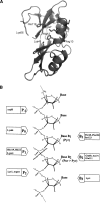

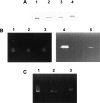
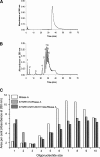
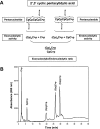
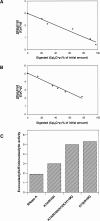
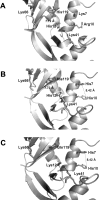
Similar articles
-
Coulombic forces in protein-RNA interactions: binding and cleavage by ribonuclease A and variants at Lys7, Arg10, and Lys66.Biochemistry. 1998 Sep 1;37(35):12121-32. doi: 10.1021/bi980743l. Biochemistry. 1998. PMID: 9724524
-
Coulombic effects of remote subsites on the active site of ribonuclease A.Biochemistry. 1998 Dec 15;37(50):17386-401. doi: 10.1021/bi981369s. Biochemistry. 1998. PMID: 9860854
-
Characterization of an RNase with two catalytic centers. Human RNase6 catalytic and phosphate-binding site arrangement favors the endonuclease cleavage of polymeric substrates.Biochim Biophys Acta Gen Subj. 2019 Jan;1863(1):105-117. doi: 10.1016/j.bbagen.2018.09.021. Epub 2018 Oct 1. Biochim Biophys Acta Gen Subj. 2019. PMID: 30287244
-
The contribution of noncatalytic phosphate-binding subsites to the mechanism of bovine pancreatic ribonuclease A.Cell Mol Life Sci. 1998 Aug;54(8):766-74. doi: 10.1007/s000180050205. Cell Mol Life Sci. 1998. PMID: 9760985 Free PMC article. Review.
-
Bovine pancreatic ribonuclease A as a model of an enzyme with multiple substrate binding sites.Biochim Biophys Acta. 1995 Nov 15;1253(1):16-24. doi: 10.1016/0167-4838(95)00138-k. Biochim Biophys Acta. 1995. PMID: 7492594 Review.
Cited by
-
Kinetic analysis of Cas12a and Cas13a RNA-Guided nucleases for development of improved CRISPR-Based diagnostics.iScience. 2021 Aug 18;24(9):102996. doi: 10.1016/j.isci.2021.102996. eCollection 2021 Sep 24. iScience. 2021. PMID: 34505008 Free PMC article.
-
RNAs coordinate nuclear envelope assembly and DNA replication through ELYS recruitment to chromatin.Nat Commun. 2017 Dec 14;8(1):2130. doi: 10.1038/s41467-017-02180-1. Nat Commun. 2017. PMID: 29242643 Free PMC article.
-
An ancient evolutionary connection between Ribonuclease A and EndoU families.RNA. 2020 Jul;26(7):803-813. doi: 10.1261/rna.074385.119. Epub 2020 Apr 13. RNA. 2020. PMID: 32284351 Free PMC article.
-
Bovine pancreatic ribonuclease: fifty years of the first enzymatic reaction mechanism.Biochemistry. 2011 Sep 20;50(37):7835-41. doi: 10.1021/bi201075b. Epub 2011 Aug 24. Biochemistry. 2011. PMID: 21838247 Free PMC article. Review.
-
The Positively Charged Active Site of the Bacterial Toxin RelE Causes a Large Shift in the General Base pKa.Biochemistry. 2020 May 5;59(17):1665-1671. doi: 10.1021/acs.biochem.9b01047. Epub 2020 Apr 24. Biochemistry. 2020. PMID: 32320214 Free PMC article.
References
-
- Alonso, J., Nogués, M.V., and Cuchillo, C.M. 1986. Modification of bovine pancreatic ribonuclease A with 6-chloropurine riboside. Arch. Biochem. Biophys. 246: 681–689. - PubMed
-
- Boix, E., Nogués, M.V., Schein, C.H., Benner, S.A., and Cuchillo, C.M. 1994. Reverse transphosphorylation by ribonuclease A needs an intact p2-binding site. Point mutations at Lys-7 and Arg-10 alter the catalytic properties of the enzyme. J. Biol. Chem. 269: 2529–2534. - PubMed
-
- Boix, E., Leonidas, D.D., Nikolovski, Z., Nogués, M.V., Cuchillo, C.M., and Acharya, K.R. 1999a. Crystal structure of eosinophil cationic protein at 2.4 Å resolution. Biochemistry 38: 16794–16801. - PubMed
-
- Boix, E., Nikolovski, Z., Moiseyev, G.P., Rosenberg, H.F., Cuchillo, C.M., and Nogués, M.V. 1999b. Kinetic and product distribution analysis of human eosinophil cationic protein indicates a site arrangement that favors exonuclease-type activity. J. Biol. Chem. 274: 15605–15614. - PubMed
-
- Bravo, J., Fernández, E., Ribó, M., de Llorens, R., and Cuchillo, C.M. 1994. A versatile negative-staining ribonuclease zymogram. Anal. Biochem. 219: 82–86. - PubMed
Publication types
MeSH terms
Substances
LinkOut - more resources
Full Text Sources

